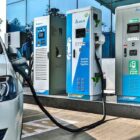The Indian government has realized the need to promote Electric Vehicles (EVs) among its growing population. The objective is to curb pollution, save precious dollars by reducing oil imports, and protect the environment. With the current government striving hard to introduce more number of EVs on Indian roads, the demand for charging stations is increasing.
EV Charging stations
Public charging stations for electric vehicles are a new experience in the country for many. Most EV owners charge their vehicles at their homes using dedicated chargers. However, home-based chargers are slow in charging and take several hours to charge fully. On the other hand, public charging stations are considered to be fast. Hence, what should you expect from E-charging stations?
Locating a charging station
- Use your vehicle’s built-in navigation system. Advanced infotainment systems provide distance to the nearest charging stations. Besides this, it provides an estimate of the vehicle’s remaining charge.
- Dedicated applications: These days, operators have launched dedicated mobile apps. You may download them on your smartphone to locate the nearest charging station.
- If your EV lacks a built-in navigation system, you may use Google Maps to locate the nearest station in your region. Google Maps are handy and offer accurate information. You may rely on them.
Other useful information
- DC or AC charging stations: Public charging stations offer quick and high-speed charging. They provide DC fast charging support with over 50kW capacity. Few premium EVs are built with high charging capacity. DC chargers can be useful.
- Unmanned charging stations: The charging station’s business model encourages unmanned operation. EV stations are primarily self-service networks. Online app support helps complete the charging process and make online payments.
- You can charge EVs with a max charging capacity of 7.2kW with higher capacity chargers, like 22kW. The reason is that the pre-programmed EV hardware determines the amount of power it can consume.
- Like your smartphone, you don’t have to bother plugging into a higher output charger than the vehicle’s input specification.
- Be aware of your vehicle’s capacity and the charger port type. Evaluate its compatibility with the public charging station.
- Indian passenger vehicles use AC type-2 charging plugs. On the other hand, DC fast-charging EVs have Type-2 CCS charging plugs.
- Few commercial vehicles have CHAdeMO charging points. Few public charging stations provide such charging points.
EV charging location
EV infrastructure in India is still in its developing stage. Charging stations are established inside existing fuel pumps, corporate parks, hotel premises, and mall parking. However, roadside public charging stations are yet to pick up pace due to a lack of confidence among investors and entrepreneurs. However, the U.P. government offers subsidies to encourage investors to launch new EV charging points in Kanpur and other cities.
EV charging capacity
Public stations might have multiple or singular points. The same premise could have varying charging points to support different EV brands and models. Charging capacity could be divided based on charging port numbers. The station might advertise a 120kW charging capacity. However, it possesses two charging ports. In reality, their optimum charging capacity is 60kW.
Waiting time
With increasing EVs and fewer chargers at public charging stations, chances are high that you wait in a queue on arrival. Few dedicated apps may provide charger-occupied notifications. It enables you to plan your charging needs accordingly. However, some apps might not. It means you have to locate another station or wait for your turn. Some owners might leave their vehicles plugged in, even after reaching 100% charge level.
Power cut issues
Power outages are common in rural areas. Frequent power cuts may disrupt the charging process. The sad truth is that charging won’t resume after power returns. You have to restart the procedure manually. Hence, keep a sharp vigil on our charging app to know the current charging status to ensure your vehicle is 100% charged.
Using digital wallets to make payments
Mobile apps operate freely and do not face any government regulations. Hence, each dedicated station has launched its own app. However, some of them could be more user-friendly. They may use separate digital wallets, which can be a hassle for most owners. Many stations do not use cash. Hence, register with a couple of digital wallets to ensure a hassle-free charging experience at public stations.
Nearby amenities
Charging your vehicle at a public charging station will take time. You may utilize this spare time to hang around or shop for essential items. Some public stations have amenities close by like dhabas, restaurants, washrooms, recreational places for children, theatres, etc. You may relax until your car gets charged fully and ready to drive long distances.
Stay informed!
It will be useful to stay well-informed about public charging stations in the country. It allows you to make the most from your charging process and ensure your vehicle stays safe and is used to the optimum.



